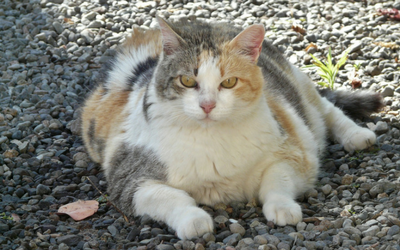
This year, October 11th marks National Pet Obesity Awareness Day. Many us spend countless hours worrying about the health of our pets, but many of our pets are overweight or obese. “What’s one more treat?” The reality is those extra treats add up and can lead to some serious health issues for your dog or cat. Those extra treats, too much food at mealtimes, and lack of exercise all contribute to obesity.
It is so easy to over-feed your pet without even realizing it. A decrease in exercise due to poor weather conditions (snow, ice, or persistent rain storms) without a corresponding reduction in the amount of kibble in your dog’s bowl can quickly lead to a gain of a few extra pounds. Even using an inaccurate measuring cup can be a source of overfeeding. Weighing your pet’s food with a kitchen scale, or using a measuring cup specifically designed for your pet’s brand of food are ways to be sure the amount is correct. Ask your veterinarian for help calculating how much food your pet should receive if you are unsure.
According to the Association for Pet Obesity Prevention, 59% of cats and 54% of dogs in the United States are overweight or obese. Pets that are overweight or obese can end up with serious health problems and their life expectancy can be reduced. Risks associated with obesity are:
- Increased risk during surgery including complications due to decreased lung, kidney, or liver function
- Increased risk of diabetes.
- Increased risk for high blood pressure, which can lead to increased risk of heart disease and kidney disease.
- A decreased immune response leading to difficulties in fighting infections.
- Reduced endurance and exercise intolerance, worsening the problem.
- Increased risk of arthritis, torn knee ligaments, and spinal problems.
- Gastrointestinal problems including constipation.
- Increased risk of cancer.
- Increased risk of skin disorders.
Some steps to take to reduce the bulge with your pet:
- Ensure you are feeding the appropriate amount of food. Carefully read the food bag or can to determine the amount your pet needs each day. The instructions on the container are average guidelines; every pet’s requirements will be different. If you are unsure, ask your veterinarian for help.
- Eliminate treats, at least until your pet’s weight is reduced. Then consider what you are feeding your pet as treats. Is it “junk food” or healthy treats? Many fruits and vegetables are safe for you pets and make great treats – ask your veterinarian what the best treats would be for your pet.
- Exercise! Take your dog for an extra walk in the day, or extend your walks by a few minutes. Remember that the pace at which you walk will impact how much exercise your pet is actually getting. A slow meandering stroll around the block will not burn nearly as many calories as a brisk walk or jog of the same distance. Play fetch or chase games with your cat or dog for 15 minutes each day to increase exercise levels.
Talk to your veterinarian to determine the best feeding plan for your pet. Different life stages require different feeding regimes. Your veterinarian may recommend a therapeutic diet to help get your pet back on track with his/her weight. We all love our pets, want the best for them, and want to keep them in our lives for as long as possible. Ensuring your pet maintains a healthy weight is one way to help keep Fido or Kitty in your life for a long time.